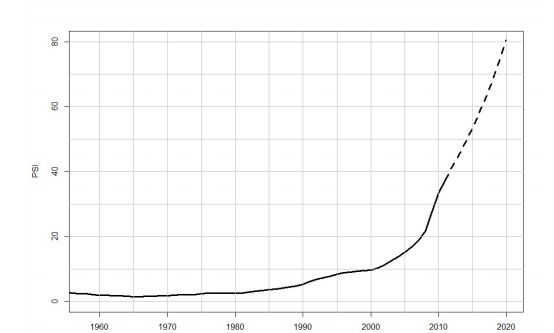Paul Cockshott
28 Nov 19
In early November I was presenting a talk on planning algorithms to the Historical materialism conference in London. A major theme of the conference was historical materialism in the context of the climate crisis. One thing that struck me at the meeting was that people seem to be underestimating the complexity of moving from fossil fuels.
I was of the opinion that the change required was of the scale of Soviet of Chinese industrialisation and would require either socialist planning or state capitalism with state coordination of the scale only previously seen in war economies. Other people seemed to think it could be achieved with a much more modest scale of investment and control.
I am thus trying to set up a collaborative group to work on doing a feasibility struggle using Soviet optimal planning theory on how to achieve the transition.
Would you be willing to work on a joint paper or small book on planning for this?
I would like to be able to get some hard figures to cover the following topics
Change in and transport infrastructure split into
Intercity freight transport,
how much in kilometer tons is done at the moment, how many trucks does this require, how many freight trains would this take, how much new railtrack would it take, what would be the requirements to build all those trains and track. How much electricity would be used to run the trains.
Intercity car transport
Same questions.
Urban transit,
how many electric buses, tramlines, etc would be needed to achieve current passenger milages by car
Air transport,
assuming this shifts to hydrogen fuel, how much hydrogen would be needed, how much electricity to produce it, assumptions about fall in demand due to higher costs etc cost of new aircraft etc
Sea transport,
implications for ships if docking by fossil fueled ships is banned and only amonia powered or wind powered ships are used, how many tons of new ships would be needed
Gas grids
Implications of cutting off methane supply to the national gas grid, how much electicity would be needed to replace the gas by electrolytic hydrogen.
Construction
What are the implications of no longer using concrete because of CO2 emissions, how much extra labour is required for masonry construction as opposed to concrete.
Steel
What is the current usage of structural steel, assume we eliminate primary steel production and just use recycled steel, how much aluminium would you need to produce to substitute for the steel.
Electricity
How much additional electric power will be needed for all this, what capital requirements are there for this etc.
We then try to construct io tables with additional rows for the other physical inputs that would change – UK tables may not be detailed enough, but the US BEA ones are, and we could use data from them appropriately scaled.
From this we then use the 5 year plan software to run scenarios which go into the report or article.
Progress
I have so far had 4 commitments to help, of varying degrees of immediacy and firmness.
One person has agreed to look at the energy production sector, I agreed to gather the initial IO table data and later to look at the road to rail transition.
For my part I have started to try to gather data for the UK initially and to process the IO tables and other data into a form usable for the plan.
What we need
- People with software experience
- People willing to research the online literature about the key industries above and determine what the comparative costs/resource uses are for low carbon techniques
- People willing to work with national statistics – either national income stats, input output tables, statistics from energy agencies.
- The above is an important skill for any marxist to acquire if they want to do analysis – think Lenin and his book Development of Capitalism in Russia or the mass of material from official data that Marx cites in vol I of Capital
Problems with using the planning software practically
- Need capital stock and depreciation tables
- This is where I am at now
- Have got a very aggregate capital stock table
- But the column titles only correspond approximately to the io table classification, and there are very few rows compared to the io table. We need to devise a plausible way to disaggregate this
- Need to handle imports and exports
- Need disaggregation of key sectors into low and high carbon intensive techniques.
Proposed technique for disaggregation by column
- Create a mapping from names used in the A matrix to those used as col names in the capital stock table. My first attempt at this was via the file translationAtocapitalstocktitles.csv I formated this by simply taking the first column (row headers) from the A matrix and hand filling in in the corresponding col names from the capital stock table. But I found that masses of the names used in the row headers and col headers do not match up. The names are almost the same but slightly different in english, or in case or in spacing etc, so that the software does not match them up.
- I made a second attempt today in the table trans.csv to do the same. But this one is not yet complete. I also modified my software that read in the files to convert to upper case and to trim trailing spaces etc. That is why I am using upper case in the last set of entries – these are names which occur in the A matrix that I have not yet worked out what industry they are.
If we assume we have a complete mapping, my intention was as follows : heading of the prototype code:
/* Programme to read in the capital stock matrix produced by stock formatter
along with a second file that relabels io table columns with the categories
used in the stock matrix and a third file that gives the value of final output
values. It then produces and expanded stock matrix on standard out such that
for each column in the original stock matrix for which several sub industries
exist in the io table the capital values in the original are spread among the
new multiple columns in proportion to their share in the final output of this
group of industries.
The final output matrix should have column names in the same order as the final
output table
*/
package planning;
import java.io.*;
import java.util.*;
class CapitalTableExpand{.....
If we can do all of that, then a similar process would have to be applied to the rows of the table to get a plausible interpolation of what a more detailed breakdown of the capital goods would be
It is then necessary to construct a depreciation rate matrix — let’s leave the problems of imports and exports for now.


